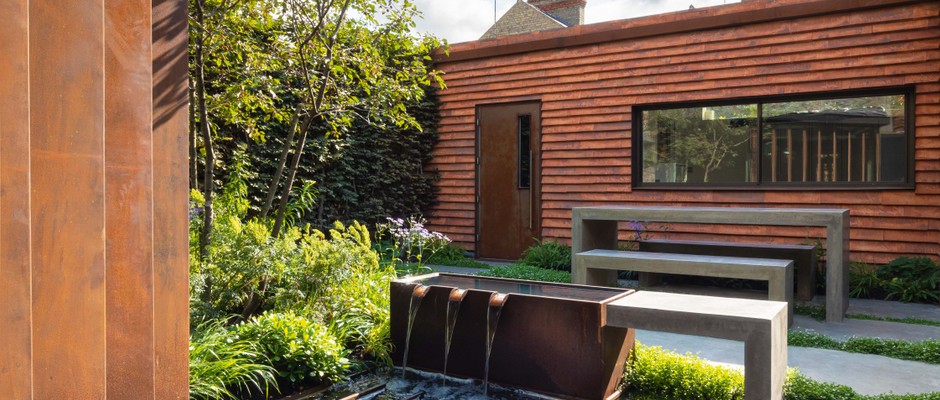
Colm Joseph's small city courtyard garden design in Cambridge
In this small city courtyard, designer Colm Joseph has used clean lines, a pared-back palette of materials and lush, woodland planting to create a sense of space and calm. Words Chris Young, photographs Richard Bloom
There’s long been debate in landscape design teaching about whether it’s easier to design a small space or a large garden. Larger gardens can be a challenge when trying to divide them into usable areas, considering borrowed views, or ensuring there is an element of planting consistency.
However, in smaller gardens every detail counts; material considerations can be contentious; and there’s no fudging any part of the build. It’s a debate that no doubt will carry on for years to come, but for designer Colm Joseph this city garden was just as much a challenge as any of his larger projects.

Colm’s practice is based on the Cambridgeshire-Suffolk border, and he’s been designing classy, considered yet usable spaces for the past five years. “I was in international development before I retrained as a garden designer – I wanted to do something more creative and stop travelling as much,” he explains. This garden – measuring just eight metres by six metres – is a clear statement of creativity. Engaged by the previous owners in 2020 towards the end of a substantial architectural renovation by of a Victorian villa in central Cambridge, Colm’s task was to bring cohesion to a space dominated by PiP Architecture’s bold architectural extension. In addition to a new kitchen there is a corridor that runs the full length of the garden leading to a home office, and these structures feature an array of materials from clay Petersen Kolumba bricks and Corten steel, to floor-to-ceiling glass, polished concrete and zinc. This was no ordinary space, and no ordinary smörgåsbord of materials. “I was excited about dealing with a bold material palette,” says Colm. “But I needed to bring cohesion and harmony.

Occupying the corner between the office studio and the long, green-roofed corridor that links it to the house, the bespoke table and benches create a shady and private seating area. The crab apple tree adds further screening and dappled shade.

In this small courtyard garden, buildings fill three of the four boundaries. To introduce some green into the space, Colm has covered the only boundary not defined by a building with pleached panels of beech (Fagus sylvatica), and sited a multi-stem Malus ‘Rudolph’ in the heart of the garden to connect it to the house.

The bespoke Corten steel water feature brings calm and helps to cool the garden in warmer weather. A series of Corten steel fins set within the pool link the trio of gently flowing cascades to the kitchen’s vertical louvres and echo the clay bricks used as cladding for the office studio and corridor.

By placing the main planting and water feature directly outside the kitchen extension, Colm has softened this striking, zinc-clad structure. Beyond, the elongated horizontal lines of the concrete furniture and paving harmonise with the geometry of the office studio.

Poured concrete, which has been used internally for flooring, is extended out into the garden where it is softened by creeping Pratia angulata ‘Treadwellii’. The garden table and benches are also cast in situ from poured concrete to a bespoke design by Colm.

The multi-stem Malus ‘Rudolph’ provides height and seasonal interest. Underplanted with a mix of evergreens, such as Blechnum spicant, and flowering plants that begin with a series of bulbs and continue with the likes of Geranium ‘Nimbus’ and Eurybia macrophylla ‘Twilight’, it ensures there is always something of interest to look out on.
Key techniques Colm uses to make small gardens feel more immersive and inviting
Simplify and unify the boundaries. Unless existing boundaries have inherent beauty or character, such as an old wall, I like to screen and green them. Hedging or climbing plants conceal boundaries, allowing your eye to rest within the space. Disguising boundaries also helps the garden feel larger. Stick to a pared-back, restrained palette of hard materials to create harmony. I usually keep to two, or maximum three, different hard-landscaping materials repeated throughout.
If it makes sense, consider repeating materials used in the architecture or interior. Avoid the mistake of pushing everything to the perimeters, leaving internal areas feeling empty. Whether it’s a small tree, tall planting, built or sculptural elements, introducing some mass helps partially conceal, reveal and frame views, adding a greater sense of depth to the space.
Introduce natural elements to soften hard materials, bringing these natural elements close to windows and the house-to-garden transition areas. This helps give the garden an immersive feel and integrates the interior and exterior. Pay careful attention to screening for privacy, to ensure you feel comfortable using the garden.
Find out more about Colm’s work at colmjoseph.co.uk

Niwaki bundle worth £57 when you subscribe
Subscribe to Gardens Illustrated magazine and claim your Niwaki bundle worth £57
*UK only

Container Gardening Special Edition
The Gardens Illustrated Guide to Container Gardening.
In this special edition, discover colourful flower combinations and seasonal planting schemes for pots designed by leading plantspeople, and essential know-how for container gardening success. Just £9.99 inc UK p&pBy entering your details, you are agreeing to our terms and conditions and privacy policy. You can unsubscribe at any time.

Gardens of the Globe
From botanical wonders in Australia to tranquil havens closer to home in Ireland, let this guide help you to discover some of the most glorious gardens around the world
By entering your details, you are agreeing to our terms and conditions and privacy policy. You can unsubscribe at any time.




